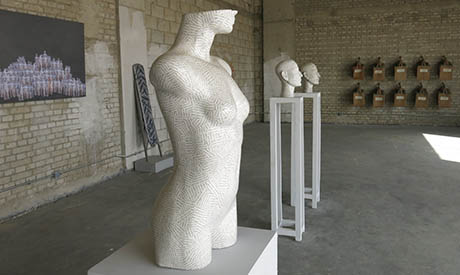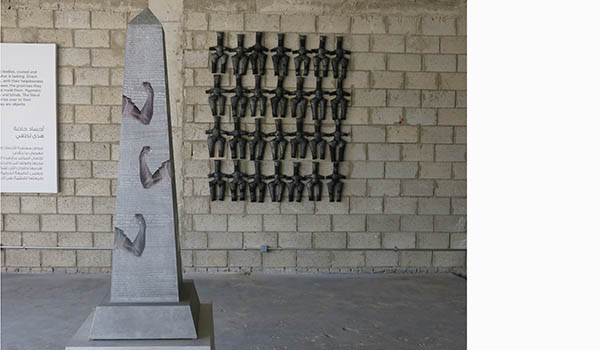
Artwork in Magnetic Bodies by Huda Lutfi at Townhouse West (Photo: Soha Elsirgany)
Townhouse, one of Cairo's leading contemporary art spaces, has extended its outreach with a new branch at the Westown entertainment hub in Sheikh Zayed, a new satellite city of residential compounds to the west of Cairo.
The new gallery, Townhouse West, aims to introduce contemporary art to a new community, outside of downtown Cairo.
Magnetic Bodies
In the venue’s first exhibition, titled Magnetic Bodies, renowned artist Hoda Lutfi explores how human bodies can oscillate between acquiring and losing meaning.
In her paintings, sculpture and installations, Lutfi uses repetition with the desired effect of desensitising the viewer’s perception and turning the redundant shapes into mere objects.
Touching on the theme of power dynamics, other works are monumental, like the sculptural piece of an obelisk. The silver obelisk stands adorned with a collage of flexed arms, a classic symbol of power, and small handwritten text that reads like a stream of thought on gender roles, labour and power.
Magnetic Bodies thus brings Huda Lutfi’s socially and politically charged pieces to the people of Sheikh Zayed, an interesting choice that raises the question of what Townhouse aims to achieve through this new branch.
The gallery’s unfinished walls add a surprisingly refreshing, modern edge to the venue.
Its large windows let in sunlight, perhaps even a little too much, as their glare makes it difficult for visitors to see a whole piece without constantly moving right and left to adjust to the light.
Reaching out in a new location
Townhouse is one of -- if not the -- leading entity that helped to create space for contemporary art in Egypt.
Founded in 1998 in the heart of downtown Cairo, it aimed to make contemporary art and culture accessible, without compromising on creative practice.
Yet, despite the Townhouse gallery’s success in expanding the art scene and effectively nurturing dialogue around contemporary art, its visitors tend to remain restricted to a circle of artists and people familiar with downtown Cairo, while those outside that circle remain oblivious to -- and detached from -- the budding contemporary art scene.
“There wasn’t a space there [at Sheikh Zayed] engaged with the contemporary arts conversation taking place in downtown,” Townhouse gallery founding director William Wells explains to Ahram Online.
The idea and location of Townhouse West comes from a collaboration with real estate development company SODIC, who developed Westown where the new gallery is located, resulting in a long-term project that serves both sides, he says.
“It was a five-year discussion process, [during which] we were looking at corporate social responsibility, and the conversation evolved into opening the space where they would give us a space as a platform to introduce Egyptian contemporary arts.”
SODIC has been involved in several art projects since 2011, including The Bridge, a travelling peace-building art exhibition, in April earlier this year.
Townhouse West is hence funded by SODIC, which offers the space rent-free, with an operational budget, while also investing in Townhouse downtown.
The space is run by Townhouse’s team, as an extension of their activities and already established outreach.

Artwork in Magnetic Bodies by Huda Lutfi at Townhouse West (Photo: Soha Elsirgany)
Catering to a different audience
The challenge for the new space is to strike a balance between exhibiting contemporary art, while also remaining accessible to a new audience with very different preferences.
“Of course it’s a totally different community," says Wells. "What we’re trying to do right now is getting to know who that community is, and we’re going to look at how one engages with a work of art. Since we opened, we realised that people are hesitant to come in, but really curious."
“I met a lot of young people in their thirties who were interested in the arts, more into modern art, but not familiar with the contemporary art conversation in downtown,” he explains. “They were very ready to talk and engage in a discussion about the art.”
Lutfi’s work was received with mixed reactions, he says.
“It started with people asking ‘What is this?’ and often asking if the place was even open yet. They eventually end up really liking the place and the effect of the unfinished walls. Then they start questioning the artwork and trying to understand it.”
Lutfi’s exhibit could be seen as a tease, on some level even highlighting a culture clash, but it is part of Wells’ aim to gently introduce contemporary arts into the Sheikh Zayed community.
“Of course we do want to maintain a particular standard in the works curated there, but one decision we’ve made is that, for the first six months, we’ll be presenting object-based work, like paintings, installations, and maybe less video art, as we feel these types of works can be more accessible.”
Wells seems to be looking at the bigger picture, with plans for the three-year partnership they have agreed on with SODIC.
“Although the works are up for sale, it’s not for making money,” he says. “The goal is to address the larger community there, which I was surprised to find to be so large. We’d also like to partner with other institutions, and we have a programme for schools.”
Townhouse West will begin their programmes with schools starting September, and according to Wells, aim to encourage children to experiment, explore and raise questions.
In the coming weeks, the space will initiate similar activities to the ones held in the downtown branch, such as talks and workshops, some of which will engage with regional and international art spaces.
“We’re really hoping this partnership will encourage other corporations to take on projects like this,” he says.
Short link: